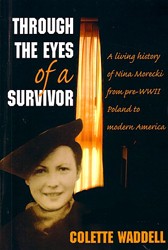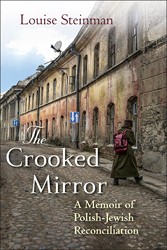Every family has its secrets. The major secret of Family History of Fear is revealed on the very first page: at the age of 19, a blond, blue-eyed Polish girl named Agata learns from her mother that she is Jewish. Confronted with such a “humiliation and a disfiguring feature,” young Agata hides the secret from the outside world and from herself. Forty years later, writer Agata Tuszyńska takes up the task of reconstructing a heritage concealed by fear and forgetting.
Growing up in Soviet-occupied Poland, Tuszyńska never met a Jew. Tuszyńska’s mother Halina survived World War II as a hidden child, having escaped from the Warsaw ghetto to the “Aryan side” with hermother Dela. As a student after the war, Halina found “refuge” and protection with the young Bogdan Tuszyński (later a famous sports journalist). Resolving to put aside the difficulty and fear of the war years, Bogdan and Halina committed to a bright vision of Communism, and to each other. Yet Tuszyńska cannot recall that harmony: “I did not have parents. I do not remember them. I had a mother. I had a father. Each distinctly separate.” Her approach throughout the book is this constant separating: dividing a nuclear family into a mother and father; sorting the maternal, Jewish and paternal, Polish grandparents, great-aunts and brothers; untangling the strings of divorces, baptisms, births and deaths. We quickly learn about Bogdan’s Polish, working-class family from Perlowa Street. And then slowly, carefully, with the help of a historian named Mirek, Tuszyńska recovers her mother’s family: the assimilated, aristocratic Przedborskis and the pious, traditional Goldsteins. She also delves deeply into the complex motives and experiences of maternal relatives who stayed in Poland after the Holocaust and after the anti-Semitic campaigns of 1968.
The book is characterized by rapid jumps and skips. The table of contents promises slices of stories — there is a “Bogdan I,” “Bogdan II,” and “Bogdan, 37” — and any odd paragraph might begin in the present day and conclude in the Third Reich. Figures move in and out of focus: a familiar Polish grandmother’s face appears frighteningly close — wrinkles and age spots magnified — but a Jewish great-grandfather with only one document to his name is summoned, blurrily, in a speculative description. Although Tuszyńska writes in the first person, stray quotes are scattered throughout and whole sections appear to be neatly reported speeches of different interview subjects. Tuszyńska herself often plays with perspectives. As the book opens, for example, she imagines herself twice: first as the little Jewish girl escaping from the ghetto, and then mere pages later as a Polish acquaintance or simply a neighbor of that little girl, watching her steps. With all of these shifts in time, space, and voice, the title’s claim to a “history” may seem surprising. But it is only through this fragmented, non-linear, polyphonic creation that Tuszyńska can hold her mixed heritage together: “Both of them — the Polish and the Jewish — are alive in me. Both make me what I am. Even if they oppose one another and accuse each other — I belong to both.”
Tuszyńska reveals a history that is raw, painful, and personal. Several times, she almost loses hope: “my efforts to stop time, to change the course of events, restore the memory despite history, the tiredness of humans, the passing of time, despite the despair, the tragedy — all my efforts seem in vain.” But she does not stop writing, researching, and remembering. This book is Tuszyńska’s beautiful, terrifying fight to bring her heritage alive in a family where fear of identity has caused a forgetting — at times passive, at times willed — on both sides. Thus Family History of Fear emerges as a work of fierce courage.
Related Content:





